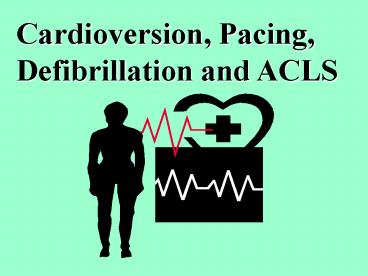Cardioversion, Pacing, Defibrillation and ACLS - PowerPoint PPT Presentation
1 / 13
Title:
Cardioversion, Pacing, Defibrillation and ACLS
Description:
CC: weakness and syncope. Pulse 106 weak and irregular. Resp 20, even and non labored ... Some atrial impulses travel through AV node - others are blocked - therefore ... – PowerPoint PPT presentation
Number of Views:3552
Avg rating:3.0/5.0
Title: Cardioversion, Pacing, Defibrillation and ACLS
1
Cardioversion, Pacing, Defibrillation and ACLS
2
Mr. Meyers
- 74 y/o male 164 pounds
- CC weakness and syncope
- Pulse 106 weak and irregular
- Resp 20, even and non labored
- BP 100/56
3
What is the rhythm strip???
- Atrial Fibrillation
- Cant measure PR interval because you dont see
the P-waves
4
Atrial Fibrillation
- Unsynchronized and rapid electrical activity with
atrial rate of 400-700 bpm - Bowl of Jello
- Some atrial impulses travel through AV node -
others are blocked - therefore ventricular rate
is slower than atrial rate and is irregular - Controlled vs Uncontrolled Ventricular Response
- Slow vs fast
5
Problems with A-Fib
- Cardiac Decompensation
- Thrombus Formation
6
Treatment of A-fib
- Medications
- Depends on Clinical status
- Stable, no Sx
- Cardioversion
- External
- Implanted
7
Pacemakers Indications
- AV Blocks
- 2nd degree HR gt 40 with symptoms
- 2nd degree HR lt 40 with or without symptoms
- 3rd degree block
- Sinus node dysfunction
8
Review of Blocks Matter of Degree.
- 1st Degree A slowing of conduction, PR interval
prolonged gt than .20 - 2nd Degree
- Type 1 ( Wenkebach)- a progressive prolongation
until a QRS is blocked, benign - Type 2 ( Mobitz II) ( Classical) -More P Waves
than QRSs, can deteriorate to no QRSs, ? no
Venrtricular activity - 3rd degree P waves and QRSs, NO RELATIONSHIP,
Ventricular rate slow Chronic Vs Acute
9
Function of Pacemaker
- Assess cardiac activity
- The sensing function
- When the sensing wire sends the signal that the
heart has not initiated the impulse the Pacemaker
will - Emit an electrical impulse to stimulate
contraction - Capture -causes Depolarization to occur
10
Various Settings...
- To Pace Atria, Ventricles or Both
- To Sense Atria, Ventricles or both
- Facts Pulse generator--Lithium battery, sealed
metal container encasing electronic circuits - Pacemaker Life 10 years, battery can be
replaced if needed
11
Complications
- Failure to discharge
- Failure to capture
- Failure to sense
- Ventricular irritability
12
ACLS..
- Advanced Cardiac Life Support
- Takes over where Basic Cardiac Life Support
leaves off - World Wide Standardization of Training and Care
- First developed in Seattle in late 1960s
- Now Field personnel, hospital, clinics, dentists
- Keeps evolving
- --newest equipment Automatic Defibrillators
- ACLS Major revision, updated, changed in 2000
13
RECAP...
- Electrical therapy to Heart
- Cardioversion- to change whats there
- Defibrillate- to take fibrillation away ( for V
Fib) - Pacemakers
- Spikes before whichever chamber they are pacing
- 10 year battery life
- Importance of standardization ACLS






























